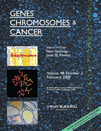Reverse painting of microdissected chromosome 19 markers in ovarian carcinoma identifies a complex rearrangement map
Abstract
Alterations of chromosome bands 19p13 and 19q13 in the form of added extra material of unknown origin are among the most frequent cytogenetic changes in ovarian carcinomas. To investigate the chromosomal composition of the 19p+ and/or 19q+ markers, we selected for examination 26 ovarian carcinomas which by G-banding had one to four 19p+ and/or 19q+, in total 37 markers. These cases were then subjected to chromosomal microdissection with subsequent reverse painting, which gave informative results on 29 markers. The breakpoints on chromosome 19 were located in both the short (p; n = 15) and the long (q; n = 10) arms, as well as in the centromeric (n = 2) and pericentromeric (n = 6) region. The analysis showed that many chromosomes added material to chromosome 19, but the chromosome arms 11q, 21q, and 22q were particularly common donors. Homogeneously staining regions (hsr) were seen in only three markers, in all of them consisting of 19p material. Eighteen markers were derived from an unbalanced translocation involving chromosome 19. In five markers, chromosome 19 was rearranged with two chromosomes. The most complex marker showed chromosome 19 rearranged with three other chromosomes, i.e., X, 13, and 16. In five markers, all of the additional material stemmed from chromosome 19 itself. This is the first large chromosome microdissection/FISH study of chromosome 19 markers in ovarian carcinomas. A detailed map of the rearrangements should provide clues to the positions of oncogenes and potential fusion genes important in ovarian carcinogenesis. © 2008 Wiley-Liss, Inc.




